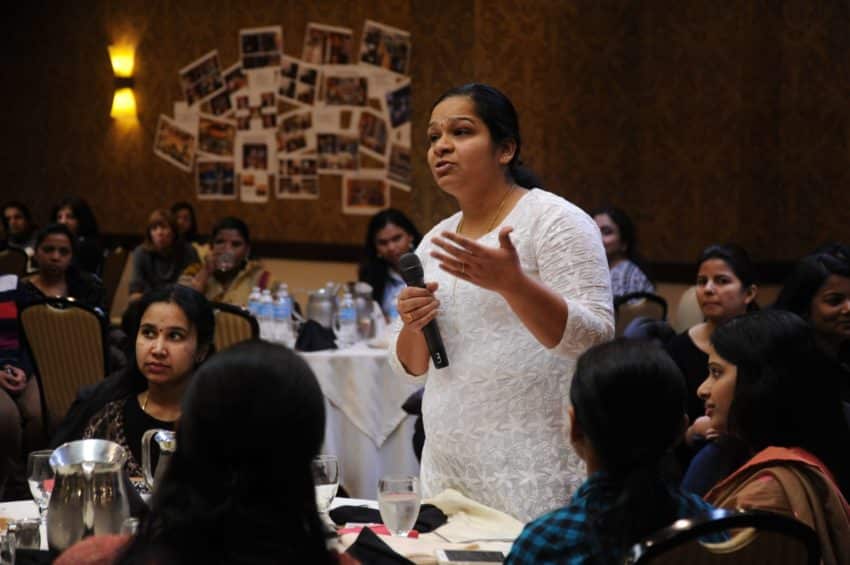What is Debating?
Updated: June 19, 2024
Published: February 14, 2020

Debating is an extremely useful skill to have. Being a good debater can bring many benefits such as job success, leadership opportunities, as well as good grades in school. If you’re wondering how to debate successfully, we’ve got all the tips you need.

Photo by Miguel Henriques on Unsplash
What is Debating
A debate is a structured contest where you try to win by creating the most convincing argument. Debates are oftentimes formal but can occur in informal settings as well.
Debate Structure
In a debate, there is usually a statement given, and participants must either choose the affirmative side or the negative side. Debate participants are given some time to prepare and then have the opportunity to speak for a set amount of time. The speakers switch turns between affirmative and negative sides, and finally a judge makes a decision on which side made the most convincing arguments and won the debate.
Roles of the Speakers
1. First Affirmative:
This person sets the scene for the rest of their team by defining terms, listing arguments they disagree with, and stating their interpretations of the topic. The first affirmative speaker also provides 2-3 arguments in their team’s favor.
2. First Negative:
They might try to change the tone of the debate by redefining definitions and then rebut the first affirmative arguments, followed by 2-3 arguments of their own.
3. Second Affirmative:
The second affirmative speaker resolves definition issues, rebuts the first negative speaker, and puts forth 2-3 new supports for the arguments.
4. Second Negative:
Continue to rebut the first affirmative arguments, but focus on rebuttal of the second affirmative arguments and deliver 2-3 new arguments against the notion.
5. Third Affirmative:
Rebut specific arguments from the second negative, and defend important attacks on their team’s arguments. Conclude the argument with a brief summary and try not to include any new information.
6. Third Negative:
Rebut specific arguments from the second affirmative, and defend important attacks on their team’s arguments. Conclude the argument with a brief summary and try not to include any new information.
Defining in the Debate
Many debaters often waste time trying to define terms within their speeches. Before you waste precious time doing so, take the time while writing your speech to determine if you really need to define a term.
Ask yourself, “Will it be confusing to judges and listeners if I don’t define this term?” and “Will the incorrect interpretation of this term be detrimental to my argument?”
That should help you narrow down the number of terms you need to define in your speeches. Stick to defining only the ones that are absolutely necessary.
How to Debate: Basic Argument Structure

Photo by Kristina Paparo on Unsplash
There are a few ways to divide the argument structure. Try to do what makes the most sense for your topic.
For example, you could put each speaker in charge of one area where the argument takes place, such as social, political, and economical. No matter what structure you choose, try to put the most compelling of arguments at the beginning of each speech if you are listing multiple arguments.
Here is an example structure:
Claim: What is your team claiming? Present the argument in a clear statement.
Evidence: Add in any evidence you have to support the claim such as quotes, statistics, anecdotes, etc.
Impact: What impact does this evidence have on society? How does this support your claim?
The Rebuttal
The rebuttal is a very significant part of the debate process. If a team can pick apart the opposing team’s evidence, then their claim falls apart.
Here are some common argument flaws to help form a rebuttal:
1. False Dichotomy:
The speaker tries to falsely divide the argument into two sides, when there are in fact many. Sometimes the speaker does this on purpose, but other times it can indicate that they don’t understand the topic well.
2. Assertion:
An assertion is when a speaker makes an argument that is unfounded, or has no evidence. Give a reason why this is an assertion by showing how there hasn’t been enough evidence to prove the validity of a statement.
3. Morally Flawed:
A morally flawed argument can be rebutted against because, although it could be true, it might be severely morally flawed. An example of this could be, “All stray dogs should be put to sleep because it will save the state money and eliminate the need for animal shelters.”
4. Correlation Rather Than Causation:
This is a common favorite. A speaker may suggest that two pieces of information are linked, when there is no evidence to support that one caused the other.
5. Failure to Deliver Promises:
You can use this in your rebuttal if you notice a speaker has forgotten to follow up on evidence they claimed they would provide. This can happen sometimes if a speaker loses track of their own argument and is a valid item to bring up in a rebuttal.
6. Straw Man:
This is when the opposing team brings up an argument against their own case and then rebuts it.
7. Contradiction:
If a speaker contradicts something that was said previously either by themselves or by a teammate, point out this contradiction as it reduces the team’s credibility.
8. Compare the Conclusion to Reality:
Try to show what it would look like right now if what the other team suggests is implemented. This will likely show how the team’s suggestions are unrealistic or will cause further problems.
How to Prepare For a Debate

Photo by Edvin Johansson on Unsplash
1. Be a Team: Work Together
Remember that you are on a team and that means you work together. Read each others’ speeches, practice in front of one another, and make sure your arguments work together and follow a cohesive line of thought.
2. Write Individual Speeches
Before you come together, break off individually and have each person brainstorm on their own. This will help to bring together a larger assortment of arguments, and will help your team identify which arguments are the main ones and should be presented as such.
3. Analyze the Evidence
You will win the debate by being able to prove that you have the most sound evidence. Triple check the evidence you have to make sure it is accurate and can be proven. Find multiple sources to back your claim.
4. Arguments for Both Sides
Be prepared by having arguments ready in favor of the other side’s argument. In doing this, you are preparing for what the other team will say and can potentially foresee comments from them as well as flaws in their arguments.
5. Prepare Your Speeches
Preparing your speech is an important part of the process. Write it first by yourself, then have your teammates look over your evidence and arguments. Try to discuss your speech frequently with your team so that you are all on the same page about what may happen during the debate.
6. Be Confident
The more prepared you are, the more confident you will become! Every second you spend preparing puts you that much ahead of the competition, so know that preparing will bring you confidence. During the debate, even if you are nervous on the inside, you can fake confidence by always referring to the evidence, pausing when necessary, and making eye contact.
Preparing for a debate is all about studying the material. For more tips on study skills, check out our blog post on what study habits to keep and which to drop.
Tips to Win Every Debate Round

Photo by Wonderlane on Unsplash
The Art of Rhetoric
- Persuade through invention:
The first part of rhetoric is invention. This means knowing your audiences’ interests and desires and playing into them.
- Argument arrangement:
A good argument arrangement goes far. Try to organize your argument by making your claim, adding in evidence, and showing the impact to support the claim.
- Improve your style by remembering your speech:
If you know your speech by heart, you can start to work on your speaking style. A memorized speech gives you confidence, and with that confidence, you can focus your efforts on delivery.
- Amplify your performance by enhancing your delivery:
Gesture, body language, tone, and eye contact are all significant parts of delivery in debate. It’s not just what you are saying, but how you say it that will win over the judges.
Improve Your Speaking Skills
- Get rid of filler words:
As you practice, take note of when you use filler words such as “like” or “um.” Get in the habit of replacing these words with silence. This will make you look thoughtful, rather than unprepared.
- Find synonyms for overused words:
When you use the same words multiple times in your speech, you bore your audience, appear unprepared, and less well spoken. Avoid this by writing your speech with different words for commonly used ones, and having a list of synonyms for words you believe you will commonly use.
- Slow your pace:
Speaking slowly and calmly helps to deliver your points effectively.
- Be calm when making rebuttals:
Making rebuttals can get exciting and heated, but overdoing the emotion is never a good idea. Remain calm but firm and confident during the rebuttals.
The Dramatic Effect
- Control your movement:
Make all your movements during your delivery neutral, open, defined, and strong. Don’t be afraid to use the full stage to your advantage, but make controlled movements.
- Maintain eye contact:
Try to connect with as many people as possible by moving your eye contact around the room. Practice doing so line by line so you increase the number of people you make eye contact with.
- Diversify your tone:
Don’t be a boring or monotonous speaker, change up your tone! Try to act as if you are talking to your audience, not reciting a speech from memory.
- The dramatic pause:
Dramatic pauses are extremely powerful, but when done at the wrong time can be detrimental to the argument. Master the dramatic pause and put it at the right time for your case.
- Close with passion:
Use a passionate tone of voice when closing — it’s something that will make your argument memorable.
A Class Debate
If you are a teacher looking to have a class debate, the format and rules can be a bit simpler than a formal, traditional debate.
First, introduce the topic to your students. Choose a topic that your students will be able to relate to. Then, allow students to choose, or assign affirmative or negative sides, making sure the number for each is even. Some teachers prefer to break those groups further in half so that the teams aren’t as big, which will give you two debates.
Give your students plenty of time for preparation, which will include research, speech writing, and practicing. Start the debate, and make sure you are keeping track of time for each speaker. Then, make your judgment. It might be worthwhile to use student judges, or teachers from another class to be the judge(s).
Conclusion
Debating is an important life skill that will help you in many facets of life. Hopefully our guide has answered all of your questions on how to debate, and has prepared you to win your next one!
